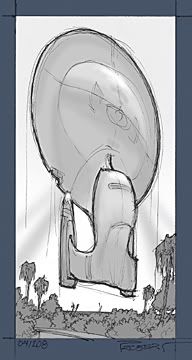Finally found it!Does anyone have Probert's original rendering of the Dyson Sphere at ground level?

Finally found it!Does anyone have Probert's original rendering of the Dyson Sphere at ground level?

Re: day/night cycles - there's always the possibility that the builders' original homeworld was tidally locked, and they don't even know what a day/night cycle IS.
How would you even achieve gravity in a Dyson Sphere?
 Unless those are very hardy high-altitude trees, of course...
Unless those are very hardy high-altitude trees, of course...Finally found it!Does anyone have Probert's original rendering of the Dyson Sphere at ground level?

Good point Christopher, I forgot that planets and the odd star can be visible during the daytime.
One thing that would be sorely missed should you live in a sphere is sunrise and sunset, seeing as the sun would be directly overhead at all times wherever you were stood.
In regards to the day/night cycle (if there was one at all) I suggest some form of atmospheric field/layer that could be programmed to let specific amounts of light through at certain points in the day, a bit like 'smart glass'. Given the technological capability of any species or civilisation capable of constructing a sphere I doubt there would be much trouble in creating a 'night switch'. Who knows, maybe during night time hours the sun at the centre of the system would look a lot like the moon should the atmospheric filters be programmed that way.
The Dyson Ring is still so, so much more plausible than the Dyson sphere in so, so many ways.
And life could probably adapt to a lack of a day-night cycle as well.
Isn't there an aphorism that, if a society has advanced to the point where they're able to build a Dyson Sphere, they won't actually have to (because they should be able to colonize other star systems at that point).
We use essential cookies to make this site work, and optional cookies to enhance your experience.
